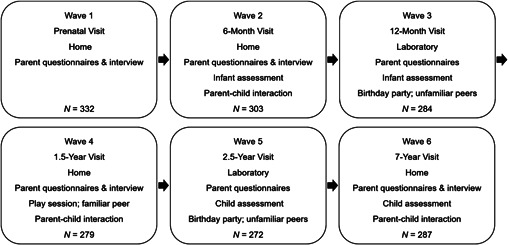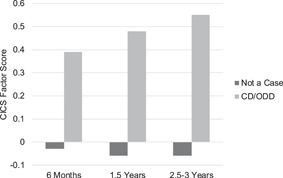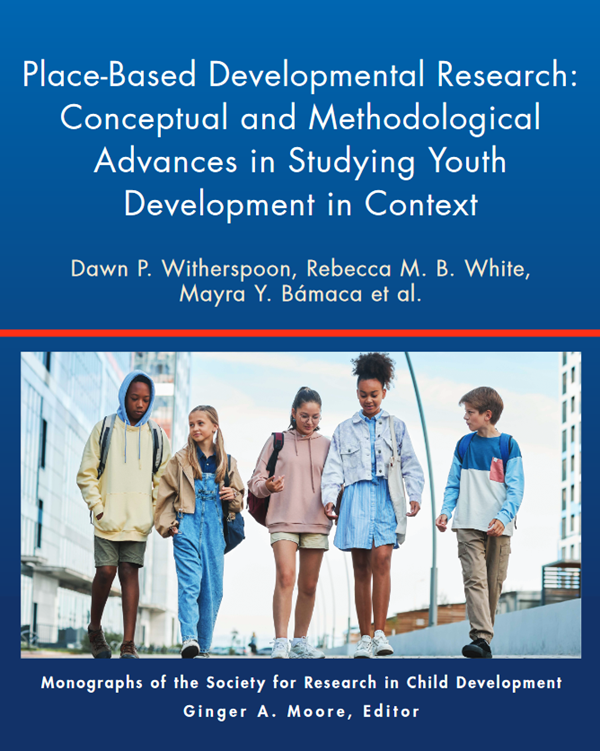亲社会与攻击行为:一项纵向研究。
摘要
发展理论家强烈主张人类婴儿具有亲社会或攻击性的本质。然而,在同一样本中,亲社会行为和攻击行为很少被同时研究。我们采用双结构、多方法纵向设计,在英国社区样本中绘制了两种行为从婴儿期到儿童期的平行发展图。数据来自卡迪夫儿童发展研究(CCDS),这是一项对父母和他们的第一个孩子的志愿者样本的前瞻性纵向研究。在2005年秋季至2007年夏季期间,从英国威尔士的国家卫生服务(NHS)产前诊所和普通诊所招募了332名母亲。潜在的参与者代表了社区的所有社会人口分类。参与调查的家庭中,中产阶级和工薪阶层家庭的比例大致相当,生儿子的可能性比生女儿的可能性要大一些,而且大多数(90%)都有稳定的伴侣关系。根据当时威尔士推荐使用的标准分类,大多数(93%)母亲报告自己是威尔士人、苏格兰人、英格兰人或爱尔兰人;其他大多数人都是欧洲或南亚国籍。在同意参与的332个家庭中,321名母亲(年龄28岁)和285名伴侣(年龄31岁)在怀孕期间接受了采访,其中321个家庭在孩子出生后至少提供了一次数据。在6个月时进行首次家访后,在儿童平均年龄约为1岁、1.5岁、2.5岁和7岁时进行另外四次测试,收集数据。数据收集在家庭住宅和卡迪夫大学之间交替进行。在孩子出生后看到的这些家庭中,有89%在最后一轮测试中接受了评估。数据收集于2015年结束。方法包括直接观察、实验任务和收集来自母亲、父亲、其他亲属或家庭朋友和课堂教师的报告。在1岁半时观察与熟悉同伴的互动。在1岁和2.5岁的实验性生日派对上与不熟悉的同伴进行互动。7岁时,对家长进行访谈,家长和老师共同完成问卷调查,儿童参与认知和社会决策任务。根据父母和其他了解孩子的举报人的报告,儿童在亲社会行为和攻击性方面的个体差异是明显的。这两种行为在第二年和第三年都表现出了稳定性。亲社会行为与攻击之间的关系随着时间的推移而改变:在1.5岁时,它们不显著相关(接近于零),但在3岁时,它们变成负相关。当孩子们与熟悉的同伴和不熟悉的同伴玩耍时,可以看到不同的模式。在一岁半的时候,当观察到孩子们在家里和一个熟悉的同伴在一起时,亲社会行为和攻击性是不相关的,从而显示出一种类似于在举报人报告分析中看到的结果模式。然而,在与不熟悉的同伴一起参加生日派对的实验中,出现了不同的模式:亲社会行为和攻击在1岁和2.5岁时都是正相关的,这有助于两个年龄的一般社交因素。亲社会行为的性别差异在举报人的报告中很明显,在一岁(尽管不是2.5岁)生日派对上也很明显。相比之下,在7岁时,亲社会行为和攻击行为的性别差异都很明显,无论是在儿童的攻击决策中,还是在父母和老师对儿童在家庭和学校的攻击行为的报告中。到7岁时,儿童的攻击性决策和行为与他们的语言技能、工作记忆和情感理解呈负相关。一些孩子出现了攻击性行为问题和冷酷无情的特征。少数人(12%)符合品行障碍或对立违抗障碍的诊断标准,这是通过早期的愤怒攻击性和对他人缺乏同理心来预测的。综上所述,这些发现揭示了儿童与其他人互动的两种逐渐分化的方式。亲社会行为和攻击行为的个体差异随着时间的推移呈现出连续性,性别差异首先出现在亲社会行为中,然后出现在攻击行为中。参与者样本和集水区的限制(例如,所有人都是首次为人父母;都是从英国的一个地区抽取的),这意味着不可能广泛地推广研究结果。在今后的工作中,进一步扩大对其他家庭和环境背景下亲社会行为和攻击行为的研究具有重要意义。更多地了解儿童在社交世界中早期出现的个体差异,可能对教育和临床实践都有帮助。


Developmental theorists have made strong claims about the fundamental prosocial or aggressive nature of the human infant. However, only rarely have prosocial behavior and aggression been studied together in the same sample. We charted the parallel development of both behaviors from infancy to childhood in a British community sample, using a two-construct, multimethod longitudinal design. Data were drawn from the Cardiff Child Development Study (CCDS), a prospective longitudinal study of a volunteer sample of parents and their firstborn children. A sample of 332 mothers was recruited from National Health Service (NHS) prenatal clinics and general practice clinics in Wales, UK, between Fall of 2005 and Summer of 2007. Potential participants represented the full range of sociodemographic classifications of neighborhoods. Participating families were divided about equally between middle- and working-class families, were somewhat more likely to have sons than daughters, and the majority (90%) were in a stable partnership. In response to standard categories recommended for use in Wales at the time, the majority (93%) of mothers reported themselves as Welsh, Scottish, English, or Irish; most others named a European or South Asian nationality. Of the 332 families agreeing to participate, 321 mothers (Mage = 28 years) and 285 partners (Mage = 31 years) were interviewed during the pregnancy and 321 of the families contributed data at least once after the child's birth. After an initial home visit at 6 months, data collection occurred in four additional waves of testing when children's mean ages were approximately 1, 1.5, 2.5, and 7 years. Data collection alternated between family homes and Cardiff University. Of those families seen after the child's birth, 89% were assessed at the final wave of testing. Data collection ended in 2015. Methods included direct observation, experimental tasks, and collection of reports from mothers, fathers, other relatives or family friends, and classroom teachers. Interactions with a familiar peer were observed at 1.5 years. Interactions with unfamiliar peers took place during experimental birthday parties at 1 and 2.5 years. At 7 years, parents were interviewed, parents and teachers completed questionnaires, and the children engaged in cognitive and social decision-making tasks. Based on reports from parents and other informants who knew the children well, individual differences in both prosocial behavior and aggression were evident in children. Both types of behavior showed stability across the second and third years. The association between prosocial behavior and aggression changed over time: at 1.5 years, they were not significantly related (the association approached zero), but they became negatively correlated by 3 years. Different patterns were seen when children played with familiar versus unfamiliar peers. At 1.5 years, when children were observed at home with a familiar peer, prosocial behavior and aggression were unrelated, thus showing a pattern of results like that seen in the analysis of informants' reports. However, a different pattern emerged during the experimental birthday parties with unfamiliar peers: prosocial behavior and aggression were positively correlated at both 1 and 2.5 years, contributing to a general sociability factor at both ages. Gender differences in prosocial behavior were evident in informants' reports and were also evident at the 1-year (though not the 2.5-year) birthday parties. In contrast, gender differences in both prosocial behavior and aggression were evident by 7 years, both in children's aggressive decision-making and in their parents' and teachers' reports of children's aggressive behavior at home and school. By age 7, children's aggressive decision-making and behavior were inversely associated with their verbal skills, working memory, and emotional understanding. Some children had developed aggressive behavioral problems and callous-unemotional traits. A few (12%) met diagnostic criteria for conduct disorder or oppositional-defiant disorders, which had been predicted by early angry aggressiveness and lack of empathy for other people. Taken together, the findings revealed a gradual disaggregation of two ways in which children interact with other people. Individual differences in both prosocial behavior and aggression revealed continuity over time, with gender differences emerging first in prosocial behavior, then in aggression. Restrictions in the participant sample and the catchment area (e.g., all were first-time parents; all were drawn from a single region in the United Kingdom) mean that it is not possible to generalize findings broadly. It will be important to expand the study of prosocial behavior and aggression in other family and environmental contexts in future work. Learning more about early appearing individual differences in children's approaches to the social world may be useful for both educational and clinical practice.

 求助内容:
求助内容: 应助结果提醒方式:
应助结果提醒方式:


